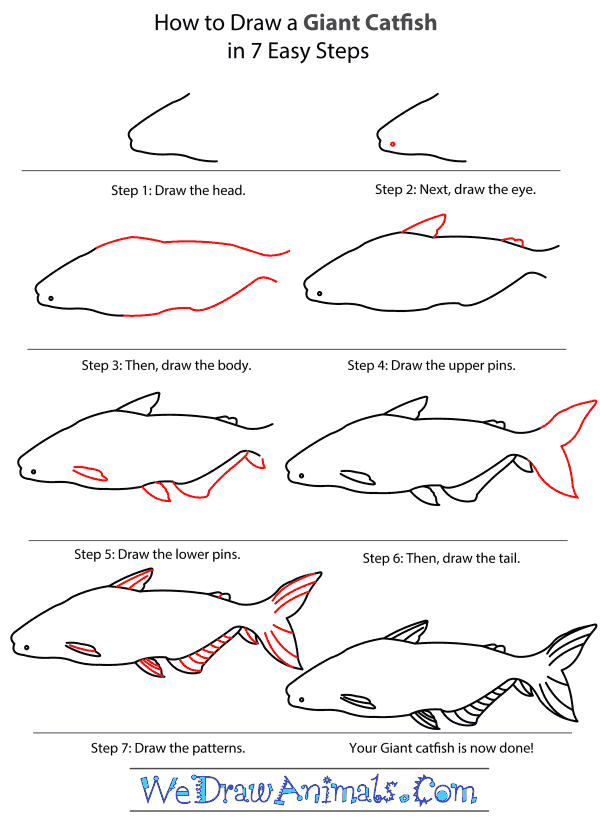In this quick tutorial you'll learn how to draw a Giant Catfish in 7 easy steps - great for kids and novice artists.
The images above represent how your finished drawing is going to look and the steps involved.
Below are the individual steps - you can click on each one for a High Resolution printable PDF version.
At the bottom you can read some interesting facts about the Giant Catfish.
Make sure you also check out any of the hundreds of drawing tutorials grouped by category.
How to Draw a Giant Catfish - Step-by-Step Tutorial
Step 1: Draw a curved, sideways M for the head.
Step 2: Draw a tiny circle near the bottom of the head for the eye.
Step 3: For the body, first draw a line from the top end of the head that angles up, then down, then curves down, and finally curves back up. From the bottom end of the head add a line that goes straight back, the curves up, down, up again, and finally down again.
Step 4: On top of the body, draw one fin on the highest point, and one very small fin near the tail.
Step 5: Draw a narrow fin on the back of the head, near the bottom. On the bottom of the body, draw one fin in the middle, a very long one on the upward curve behind it, and a small fin near the tail end behind that.
Step 6: End the tail in a wide, sideways W-shaped fin.
Step 7: Draw lines on all of the fins. Done! You can color it any shade of grey to white. These fish are native to the Mekong River in Southeast Asia.
Interesting Facts about the GIANT CATFISH
The Giant Catfish is a member of the fish group and the scientific term for them is Pangasianodon gigas. Another common name for this species is the Mekong Giant Catfish. It lives in a river of the Mekong basin at Vietnam on Southeast Asia. Legends of Thailand make this fish highly revered, so there are rituals and offerings made to this creature on a regular basis. This creature is the largest freshwater fish in the world.
Did you know?
- This animal was first documented in 1931.
- The species is up to 13 feet in length.
- They have a weight of up to 660 pounds.
- This creature becomes fully grown in 5 years.
- The babies convert from carnivorous to herbivorous in about 1 year.
- Their swimming range is over 30 feet deep.
Former sightings have placed this creature in China and Cambodia, but currently it only officially resides in the brackish water of the Mekong River delta at the sea. This animal is harmless to humans as they contain no teeth. As babies this species eats zooplankton and can be cannibalistic. Afterward, the fish feed on filamentous algae from rocks and occasionally ingest larvae, algae, bacteria, and microbes. These animals have a low population amount, and are considered to be critically endangered to the possibility of extinction.








